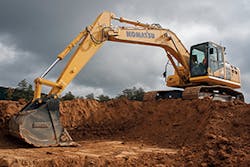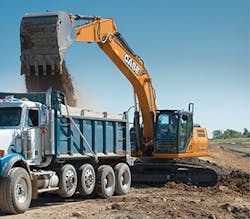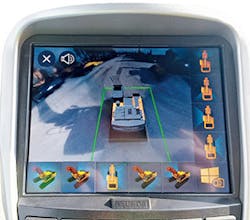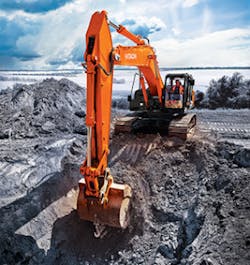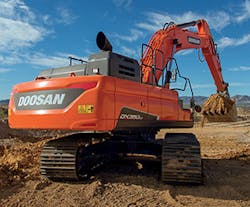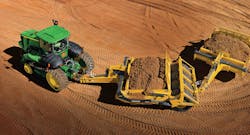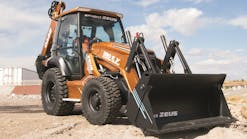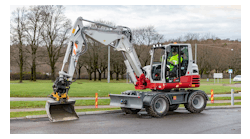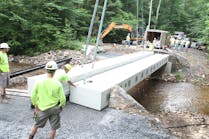Many owners of grading and excavation contracting companies concur: finding enough skilled employees to execute jobs continues to be difficult.
The answer to that challenge may lie in more robotic-like machines. Machines that do more on their own—without human intervention—will require fewer employees. On the other hand, robotics may even attract people who like to work with electronics who hadn’t previously considered the construction field.
That lack of labor is driving adoption of technology, be it telematics or machine control, points out Jena Holtberg-Benge, director of John Deere WorkSight.
She references statistics from studies such as that done by the Associated General Contractors of America that concludes up to 86% of construction companies are struggling to find skilled operators.
“How do you then take an unskilled operator and put him in the cab of an excavator, or how do they increase the functions of an excavator and thereby have fewer of them but one really skilled operator?” points out Holtberg-Benge.
That is addressed through the adoption of machine controls as well as usage of telematics, she adds.
“If you think about fleet management, the fleet manager is looking at utilization across their fleet and addressing the number of assets they’ve got based on that utilization,” says Holtberg-Benge. “We’re seeing better usage of that data to be able to make those kind of decisions as a result of this lack of skilled labor.”
Indeed, machine control guidance will be the industry’s focus on next generation excavators, notes Sebastian Witkowski, product marketing manager with intelligent machine controls at Komatsu America Corp.
Komatsu has introduced the world’s first 3D GNSS machine control excavator, points out Witkowski, adding that the company’s machine control technology is fully scalable.
“We have made it easier to put grading systems on our excavators,” says Mark Wall, product marketing manager of excavators for John Deere. “We are mindful that we are open architecture, even on our graders and dozers. We like to play equally with all of the grade control companies, whether it be Topcon, Trimble, or Leica. There are building blocks which initially start with the grade reference systems and we’ll continue to build on that as we move forward.”
CASE CX25OD hard at work
In looking to improve next-generation equipment, John Deere’s product development process is influenced by input from a customer advocacy group, says Wall.
“We use these customers to help determine what they are looking for in that next series machine, whether it is better fuel economy, more productivity, or lower ownership and operation costs,” says Wall.
That feedback, which starts with a benchmarking, moves all the way into the point of production. “We’re in a portion of that now to have customers help us determine what that next series looks like relative to electronics, automation, and training,” he adds.
John Deere sometimes receives feedback on issues “we may not have thought about, but [are] important to the contractor,” points out Wall. For example, in the company’s current G Series, the reversing fan option came about from contractors’ requests.
“We had contractors then that had worked in some high-debris areas. They said one of the issues they get is in pulling that debris into the cooling systems and having to clean them,” says Wall. “From that, we designed our cooling systems so that we have a screen on the outside of the machine that collects a lot of big debris, and if it passes through that screen, it goes through the openings in the coolers. If it doesn’t, it will automatically reverse that fan every hour or you can automatically reverse it and it will clean that debris out of the system. The way we did it with a hydraulically-driven fan benefitted the contractors.”
Contractors welcomed the change on several levels. One was noise reduction, as the fan only runs as fast as it needs to, notes Wall. Fuel economy from not having to spin a large fan at rated engine speed became another benefit.
A third benefit was increased uptime. “Contractors tell us they don’t have to worry about trying to get in every interval and clean out the cooling cords,” points out Wall.
To stay competitive, contractors who use Doosan equipment indicate they desire a “durable and productive machine” that will have little downtime, notes Shane Reardon, excavator product specialist for Doosan.
Contractors also seek increased fuel efficiency, as well as operator comfort and visibility in the cab, which are areas of focus going forward, says Reardon.
Hyundai all around view monitoring system
Grade control is a technology gaining momentum and may become standardized in the future, points out Reardon, adding that it’s gaining a lot of popularity in that it eliminates the need for employees on the ground holding grade sticks.
“The operator can sit in the cab and know where his grade is, allowing him to know how much to cut,” says Reardon. “He’s not over-digging and hauling excess material out, which may have to be hauled back in with fill. So they’re saving on materials as well.”
“Construction is a competitive business, and contractors are always looking for machines that produce more and do it more efficiently,” notes Corey Rogers, marketing manager with Hyundai Construction Equipment Americas.
The company is adding models and configurations to the Hyundai HX series it released last year.
Hyundai’s next-generation excavators are designed to meet Tier 4 final standards, provide 10% more fuel efficiency, and be 5% more productive, with increased breakout force and faster cycle times, says Rogers.
The company has put a focus on ease of operation and safety through such features as the all around view monitoring system (AAVM), which draws information from four cameras to create a 360-degree view to the work environment.
“This visual data is combined with our new IMOD dynamic object-detection system that helps operators take note of workers, equipment, or other objects in motion up to 16.5 feet away from the machine,” says Rogers. “This information is displayed on the large, automotive-quality touchscreen monitor that also provides access to other data and controls.”
Hitachi excavator going deep
The operator has fingertip access to everything from power and performance settings to operator preferences and diagnostic functions, he adds.
Other safety improvements include additional handrails on the upper structure, along with Hyundai’s anti-slip surface, designed to reduce the likelihood of falls on the upper structure. The HX series features new falling object protective structures- and rollover protective structures-certified cabs. With the addition of optional falling object guard, the cabs meet Falling Object Protection’s Level 2 requirements, says Rogers.
“The HX series excavators enable operators to keep their eyes on the work at hand safely and conveniently with features including hands-free calling, an innovative haptic controller for remote control of all monitor functions, [and] improved visibility with the new, distortion-free flat glass,” says Rogers, adding that the design of the glass panels makes them easier and less expensive to replace, should that ever be necessary.
As with other companies, Hyundai relies on end-user evaluation of equipment performance in the field to serve as a springboard for improvements going forward, notes Rogers.
Regulations also drive changes. “We all realize that Tier 5 emission standards are just a few years away,” he adds.
In looking to the next generation of excavators, Kubota focuses on the technologies offered by such products as its advanced load-sensing hydraulic system, designed to increase efficiency by providing optimum oil flow to each cylinder, notes Tim Boulds, Kubota Construction Equipment product operations manager.
The company also is focusing on fuel economy, “which in turn helps support the environment,” says Boulds.
“Kubota’s ECO PLUS feature allows operators to increase fuel savings with the flick of a switch and our auto idling system significantly reduces fuel consumption as well as noise,” he adds.
Manufacturers “will undoubtedly continue to work towards meeting the ever-changing needs of contractors and the race towards emissions compliance has yielded significant machine improvements across the industry, providing a platform for the evolution of tomorrow’s machines,” notes John Bauer brand marketing manager with CASE Construction Equipment.
Last year, CASE introduced its newest generation of excavators, the D Series, with seven models ranging from the 29,131-pound CX130D to the 82,483-pound CX350D.
Recent innovations have resulted in significant gains in speed and power through the use of larger control valves, enhanced electronics, and the CASE Intelligent Hydraulic System (CIHS), says Bauer.
The goal of CIHS is to ensure the best use of the machine’s hydraulic power and momentum “to use that power for productive purposes instead of wasting that energy, which increases speed while reducing fuel consumption,” he adds.
Special features not only result in excavators that are easier to use, but also provide ease in training operators new to the machinery.
“Traditional aftermarket indicates guidance systems can be difficult to learn and are often burdensome to effectively operate,” points out Witkowski. “Komatsu’s fully integrated machine control system is designed to eliminate the struggles associated with manual excavation/finish grading to target surface.
“With semi-automatics engaged, Komatsu’s intelligent excavator automatically limits the bucket from digging below target surface. It will automatically adjust the boom height, allowing the bucket to trace the target surface. The addition of actual automation limits over-excavation and aids in accurate finish grading, which in turn frees the operator to focus on moving material efficiently.”
Equipment that is user-friendly and easier to train on has become “critical,” notes Boulds. To that end, Kubota’s digital displays are designed to provide operators with easy access to a variety of operational functions at their fingertips, he adds.
“In addition, Kubota’s dual auxiliary hydraulic ports are easily operated and expand attachment usage for even greater versatility,” says Boulds.
Easy maintenance is also a benefit.
Kubota’s excavators feature details such as Triple Open Covers, ground-level access, and angle track frames, points out Boulds.
Better usage of data goes to training, says Holtberg-Benge.
John Deere recently integrated grade control and grade control systems on excavators that to a certain extent enable an operator to function “blindly” in the cab, says Holtberg-Benge.
“You can train an operator to dig in a situation where they may not be able to see as a result of having that grade reference,” she says. “It’s safer and easier for them to do that as a result of this system. This has a big impact on the lack of skilled labor.”
“It’s amazing what contractors can find in that machine to prove useful,” notes Wall. “If they’re looking at utilization and idle time on an excavator, they can determine if they need more equipment to support that excavator.”
For instance, if a contractor is doing mass excavating and the idle time on a machine is significantly high, the contractor may decide to rent another truck, which may increase the uptime on the excavator and provide greater productivity, he says.
“They may decide they want to downsize the excavator, use a smaller asset, and lower their owning and operating costs if they have a different asset that’s idle that they can put in and move a larger excavator to a different job site,” adds Wall.
To meet Tier 4 Final regulations, all CASE D Series excavators feature a combination of cooled exhaust gas recirculation, selective catalytic reduction, and diesel oxidation catalyst technologies.
“By eliminating the diesel particulate filter and the regeneration and lifetime maintenance costs associated with it, the engine ultimately runs cooler and more efficiently,” says Bauer, adding that it results in cycle times up to 12% faster, break-out forces up to 6% greater, and fuel efficiency up to 14% greater than previous models.
The series also has more standard features, such as a pattern selector designed to be easier, he adds.
In including features that make excavators easier to use and train on, CASE focuses on automated functions that enable an inexperienced operator to perform at a higher level and for an experienced operator to be able to get more work done than he or she was previously able, says Bauer.
“The primary goal is to give operators the ability to achieve higher productivity through automation and ease of use,” he adds.
New excavator models feature an intuitive Control Pattern Selector, allowing operators to switch between ISO and Society of Automative Engineers patterns so the operator can set up the controls to levels with which they are familiar.
Each model also employs a Free Swing feature for added control when craning or lifting offset loads. CASE offers three selectable modes to help the operator match machine output to the job at hand, designed for easier operation as well as a further reduction of fuel consumption.
Maintenance has also been simplified with accessible service ports, designed to make daily inspections and basic maintenance easier and more efficient.
Since Tier 4 is a concern that is essentially in the rear view mirror for many companies, the focus now is on innovations.
For Kubota, that means developing and improving its current lineup with regards to performance and comfort, says Boulds.
“Productivity and efficiency remain primary goals, and while there has been a heavy focus on Tier 4-related engine technologies, it’s actually the technologies built around it that really improve these profit drivers,” says CASE’s Bauer. “The new generation of excavators is being built stronger to support the added capabilities of the machines.”
CASE has built the arm and boom of each of its newest excavators “much stronger for greater durability and support, and the undercarriage has been built with thicker steel to provide an even stronger, more stable base,” he adds. “These platform improvements help build the foundation so that machines can deliver added speed and power.”
A Doosan DX350 digs up some dirt
Modern hydraulics systems are more efficient, “smarter,” and reliable than they were previously, says Bauer.
That plays into CASE’s larger goal of making equipment more practical and intuitive to use while also improving on the power needed to get work done, says Bauer.
Case in point: greater efficiencies are being derived by switching from fixed displacement work pumps to variable displacement, he adds.
The pump only puts out as much flow as needed, says Bauer.
“Traditionally, a lot of construction equipment used fixed displacement,” he says. “If you only needed to make minor adjustments to your work function, most of the flow was being dumped over a relief valve, which created extra heat in the system. By having a variable displacement, you only produce as much flow as needed.”
CASE also is designing equipment with more pumps.
“Having one pump that does everything may make it very compact, but it also makes it less efficient,” says Bauer. “By putting in multiple specialized pumps, we are able to match the pumps to the pressures that are needed and reduce throttling losses.”
Hyundai is increasing the use of electronics.
“Contractors will see this in expanded use of touchscreen technology that allows the operator to make quicker, better-informed choices over a broad range of operating parameters,” says Rogers. “Examples include the ability to select work mode and operation-performance measures and to easily switch between attachments with different hydraulic flow usage.”
The company has made standard on the HX series excavators features designed to improve ergonomics and thus make the operator more productive, notes Rogers.
Those features include fully adjustable seats, adjustable arm rests, lumbar adjustment, heated seats, and air-ride seats. The Hyundai HX series also features a newly-designed crank-style adjustment of the joystick arm console—ratcheting forward and up and back and down through one linked ratcheting crank.
“It’s convenient and easy to access and allows easy adjustment to the operator’s size and build,” says Rogers.
Hydraulic controls on an excavator get the highest marks from contractors, says Wall. The hydraulics offer optimal controllability, and with combined functions, the controls are favored features, he adds.
“As we go forward, there are different ways of designing control systems that enable other features and that’s got to be studied so as to not lose controllability today,” says Wall.
Modern hydraulics is “smarter,” points out Bauer.
“Manufacturers have gone from hydro-mechanical systems to electro-hydraulic systems, and with that comes improved functionality that may be an automated function, more productivity choices, or easier to select options,” he adds.
Witkowski notes there is a strong trend for increasing automation in the industry, moving toward autonomous excavators.
The industry has moved from grade checkers and stakes to aftermarket 3D GNSS indicate/machine guidance to actual 3D GNSS automated machine control with the introduction in November 2014 of Komatsu’s PC210LCi-10, he adds.
While CASE currently has no commercial plans for a “truly autonomous” excavator, there are existing technologies making operation more “hands-off” and operator-friendly, notes Bauer.
“With today’s ‘connected job site’, there are two primary technologies at work in the market: telematics and machine control,” he adds. “CASE launched the SiteWatch telematics system in 2013, and the industry continues to see customer adoption rise daily. In 2015,we’ve increased the number of parameters—up to 40 on each product line—allowing all tracked parameters to be recorded, eliminating the need for equipment owners to choose, and providing a more robust data set to monitor and help make more intelligent business decisions.”
CASE is strategically partnered with Leica Geosystems to provide and develop machine control systems for CASE equipment. Additionally, the company has placed a dedicated “precision construction” specialist in as many dealers as possible nationwide to work with sales staff and customers to better understand how these systems complement the equipment they are buying and already own, adds Bauer.
Machine control and telematics will continue to see increased adoption in 2016 and beyond, says Bauer.
“For machine control, there are real tangible benefits related to earthmoving: it makes it easy to set grades and prevent either under- or over-excavation,” says Bauer. “This allows operators to get the work done right the first time, increases total productivity, and reduces the wear and tear on a piece of equipment.
“Telematics continues to evolve, and provides equipment owners with real actionable data helping them improve everything from productivity to maintenance and overall machine health—all remotely,” says Bauer, adding that many manufacturers now offer telematics subscriptions as part of the initial purchase or lease of an excavator.